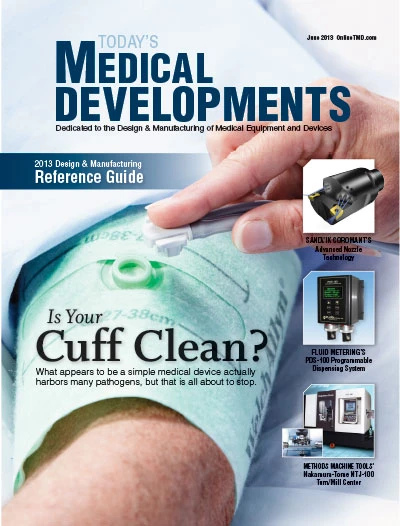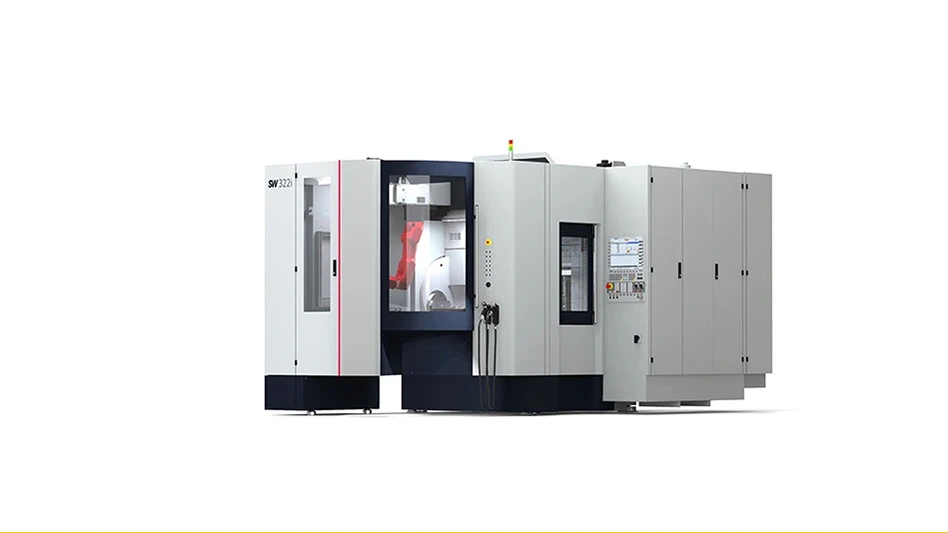 The individual parts of the bone anchored port are precisely measured and the machined metal surface cannot contain a single scratch. |
High-quality materials are required for the watch making and jewelry industry, as well as for dental and medical engineering. The Cendres+Métaux Group has extensive experience in all of these areas. Since its beginnings in 1885, the Swiss company has grown into a worldwide corporation with more than 450 employees.
The development of next-generation products and services is part of the success at Cendres+Métaux. In recent years, the company has expanded heavily into medical engineering, which is now a very important business sector alongside its dental, jewelry/watches, and refining sectors. In addition to the company’s own products, which are developed and sold for the dental market, Cendres+Métaux produces customer-specific micro-mechanical products using high-quality biocompatible materials. Design is also offered as a service. All products are manufactured at company headquarters in Biel, Switzerland, and more than 90% of the company’s products are exported abroad.
High-Performance Tools
Expansion is on the agenda for the future at Cendres+Métaux, where high-performance tools are viewed as the foundation for innovation and quality leadership. To that end, Cendres+Métaux converted early – in 1991 – to 3D software for technical design and development. However, for some years its design engineers have been using multiple brands of software systems for various business sectors, between which data exchange was impossible.
“For a team of 12 people this is not very practical,” says Mathias Strazza, head of product development.
So, the company decided to switch to a shared system and to establish an integrated process from development to production. After a selection process, Cendres+Métaux chose NX software, an integrated product design, engineering and manufacturing solution from Siemens PLM Software, migrating all of its data to this system. Today, the company is using NX CAD (computer-aided design) for design/development projects, NX CAE (computer-aided engineering) for finite element modeling (FEM) calculations and simulation, and NX CAM (computer-aided manufacturing) for the production of highly complex, small parts.
A phase of in-depth evaluation, in which a project team from Cendres+Métaux defined various requirements for the new system, accompanied the decision-making process. One important factor was the integration of new production opportunities with 5-axis machinery that could produce even more complex and angled parts with free-form surfaces. Processes from development to production also needed to be optimized – with a significantly shorter prototyping phase and reduced risks thanks to simulation and strength calculations. A unified system throughout the company was ultimately intended to enable rapid data exchange and reduce information technology (IT) time.
The core competences of Cendres+Métaux, including the micro-mechanical production of medical, dental, watch and jewelry products, were also to be taken into account. These pose extreme challenges for product development.
“It might be easy to enlarge these parts on screen, but the fact remains that our geometries are on a microscopic scale,” Strazza says. “You need to bear that in mind at all times in product development. It must be possible to manufacture and also accurately measure the parts.”
The system therefore needed to be able to display and implement extremely small parts with special geometries and structures for a wide range of products.
Critical Parameters
Since the company began using CAD software in 1991, Cendres+Métaux has archived relatively large amounts of data.
 The simulation capabilities of NX are used to achieve the best possible design and reduce costs. |
“We cannot afford to lose any of our data, because of the long lifespan of products for the medical sector,” Strazza says. “This means that we need to keep all of the data, so that we are able to supply spare parts for our existing products for a specific period. The migration of a lot of older data into the new system was one of the challenges of the system transfer.”
Another requirement was problem-free data exchange with customers and suppliers.
“We have a wide variety of systems to deal with, so it is important that our software supports as many formats as possible, that is, import, export, and exchange,” Strazza says.
A subsequent market analysis showed that NX is a system well established in the medical sector and can offer specific, high-value programs.
“There are plenty of skilled operators of this system in the marketplace, and it is also used at universities,” Strazza adds.
Both Cendres+Métaux and Siemens PLM Software benefit from the cooperation.
“The experience Cendres+Métaux has gained from working with NX will be used in the development of the next release of Siemens PLM Software,” Strazza says. “There is a win-win effect for both sides.”
On the practical side, such as modeling high-precision microscopic parts, Cendres+Métaux and Siemens PLM Software have enjoyed very good experiences, according to Hans Messerli, a design engineer at Cendres+Métaux. Even in the case of changes, it has been possible to quickly build on the parts created with NX and from the very early phases of product development.
 Top: The multi-phase processing of micro-mechanical parts requires an ultra-careful CAM manufacturing strategy. The powerful machining strategies within NX are used to achieve a faster and more intuitive process. Bottom: Complex micro-mechanical parts are developed efficiently in an integrated process using NX. |
“This is a very important point, which says a lot about Siemens PLM Software,” Messerli says.
He notes that a decisive advantage of Siemens PLM Software’s NX was the integration of design, simulation, and manufacturing capabilities into one system.
“Everything is integrated in NX,” Messerli says.
He also points out that the synchronous technology capability developed by Siemens PLM Software works together with NX functions, so that existing data need not be converted or re-created.
Existing data can continue to be used with each operating step. Data from external software systems can be integrated quickly and easily.
“The handling and processing of software data is far simpler than with other software systems and permits a lot of flexibility,” Messerli says.
For Cendres+Métaux, the result is that technical design speed has significantly increased.
Maximum from 3D Data
The efficiency of the system is demonstrable in the prototype phase. With the use of NX, design processes are accessible simultaneously and transparently throughout the entire group. It is here that Mischa Tahedl, technical designer and then-project manager for the updating of the CAD/CAM infrastructure at Cendres+Métaux, sees the greatest time saving.
Tahedl explains, “Because data is accessible at all times, we can work in parallel and start programming the machinery, while the 2D drawing is still being created. This saves us a lot of time over the whole process.”
In general, simulation helps reduce costs and meet quality requirements.
“We get the maximum from the 3D data,” Strazza says. “In fact, the 3D data gives us something tangible on the screen, without having to spend time and effort making a product.”
The products of Cendres+Métaux need to meet high standards in a small space. Since the parts are subject to a great deal of wear, strength testing is a major issue in the simulation.
Messerli explains, “The simulation lets us optimize the design quickly, because we can see exactly where the stresses occur.”
Conventional tests merely show that something has broken. This is a notable issue, particularly when manufacturing with synthetic parts using expensive tools.
“Here again, simulation helps keep costs down and helps us achieve the best possible design,” Messerli says.
Messerli believes that the synchronous technology provided within NX will ultimately protect future security. “For us, it is also a signal that we are continuing to develop and that, as a customer, we are not being left out,” he says.
The support of Siemens PLM Software during the migration has been a key part of this. Cendres+Métaux equally values the geographical proximity of its service provider. Due to the long service life of its products, the issue of reliability is central to the selection of a partner. Leveraging of NX is widespread, including use by large companies.
“This means we can expect to be able to continue using our CAD data long into the future,” Messerli says.
Powerful Machining Strategies
The 3D models ultimately make their way to Urs Stettler, who is responsible for the manufacture of micro-mechanical products at Cendres+Métaux. A large machine shop with 3-axis to 5-axis milling and turning machines is available for production at the site in Biel.
 NX is used from design through manufacture for the components of the bone anchored port. |
“We can now make practically anything required on the machines,” Stettler says. He also commends the “extremely powerful machining strategies” of the NX product development team. “I do not know of any other system with so many solution options,” he says.
Use of NX to develop the company’s advanced medical products verifies this.
For example, Cendres+Métaux developed a medical sector project – a bone-anchored port for dialysis patients. Here, the particular requirements were the complexity and sensitivity of the micro-mechanical parts.
“Scratches are simply not allowed,” in such work, Stettler says.
Using NX, he configured the CAM strategy with processes such as gripping, cutting, and unloading. Thanks to using NX, the process is much faster and more intuitive than before.
“The machine just does what I want,” Stettler comments. He also notes that with good preliminary work from other departments, “It is also extremely easy to produce customer proposals with 3D models created using NX.”
Siemens Industry Software
Plano, Texas
www.siemens.com/nx
Cendres+Métaux
Biel, Switzerland
www.cmsa.ch

Explore the June 2013 Issue
Check out more from this issue and find your next story to read.
Latest from Today's Medical Developments
- Tariffs threaten small business growth, increase costs across industries
- Feed your brain on your lunch break at our upcoming Lunch + Learn!
- Robotics action plan for Europe
- Maximize your First Article Inspection efficiency and accuracy
- UPM Additive rebrands to UPM Advanced
- Master Bond’s LED415DC90Med dual-curable adhesive
- Minalex celebrates 60 years of excellence in miniature aluminum extrusions
- Tormach’s Chip Conveyor Kit for the 1500MX CNC Mill





